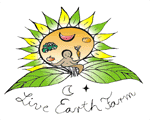
~~~~~~~~~~~~~~~~~~~~~~~~~~~~~~~~~~~~~~~~~~~
Live Earth Farm (Com)Post
3rd Harvest Week, Winter 2007/2008
Wednesday Dec. 12th, 2007
~~~~~~~~~~~~~~~~~~~~~~~~~~~~~~~~~~~~~~~~~~~
In this issue
--Greetings from Farmer Tom
--New Sustainable Ag Education program on the farm
--Kommunity Kraut
--Pictures around the farm
--What's in the box this week
--Notes from Debbie's Kitchen
--Contact Information
"Again, again we come and go,
changed, changing. Hands join,
unjoin in love and fear, grief and joy.
The circles turn, each giving into each,
into all."
~ Wendell Berry
Greetings from Farmer Tom
~~~~~~~~~~~~~~~~~~~~~~~~~~~~~~~~~~~~~~~~~~~~~~~~
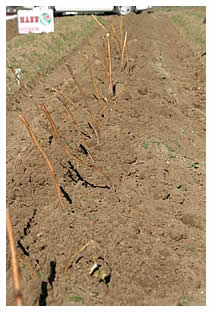 The
farm never stops. We are busy planting next years raspberries, both yellow
and red varieties (those are the newly-planted canes, at left), the pear and
apple trees are dormant enough already to be pruned, and the strawberries are
mulched (more pictures below). Last week, together with 12 Wavecrest students
and staff, we planted a 300+ foot long hedgerow with probably over 150
native perennial plants. The students were incredible; in less than 2
hours we completed the project, just when the first raindrops started
falling, bringing much needed rain for the plants.
The
farm never stops. We are busy planting next years raspberries, both yellow
and red varieties (those are the newly-planted canes, at left), the pear and
apple trees are dormant enough already to be pruned, and the strawberries are
mulched (more pictures below). Last week, together with 12 Wavecrest students
and staff, we planted a 300+ foot long hedgerow with probably over 150
native perennial plants. The students were incredible; in less than 2
hours we completed the project, just when the first raindrops started
falling, bringing much needed rain for the plants. Hedgerows are a great way to introduce native vegetation back into the farm landscape, attracting beneficial insects, creating habitat for wildlife, and reducing erosion and improving water quality along drainage ditches. We hope to plant another 600 feet of hedgerow over the next couple of weeks before the next cycle of rains. Thanks to CAFF (Community Alliance with Family Farmers) and The Wild Farm Alliance, we were able to initiate this project, which will not only benefit the land but also our educational efforts on the farm (see next section of newsletter).
Wendell Berry's poem describes how farming is like a living organism, where the dynamic cycle of the seasons is inevitably one of change and renewal. This week after we harvest for and prepare the last shares of the year, we can take a breather and, like seeds gestating in the dark rich soil, can turn our focus towards that inner dark richness within, unknown, but certainly renewing and inspiring.
Wishing you a Happy New Year and a Peaceful and Nourishing Holiday Season - Tom
<back to top>
New Sustainable Ag Education program on the
farm
~~~~~~~~~~~~~~~~~~~~~~~~~~~~~~~~~~~~~~~~~~~~~~~~
Hello CSA members. Since Tom is busy getting ready to visit his family
in Germany, I thought I would take this space and time to introduce myself. My
name is Jessica Ridgeway, I live in Aptos and Tom and Constance have hired me
to get an educational nonprofit organization and programs started here on the
farm. I feel so lucky to have been provided this opportunity.
I am originally from New England and I made Santa Barbara and Santa Cruz my home
for eight years before I returned to New England for a Master’s Degree
program in Environment and Natural Resources at the University of Vermont in
Burlington. During my two years in Vermont I studied Ecological Design
and Environmental Education. For my master’s thesis I used a Participatory
Action Research methodology to start a school and community garden and Sustainable
Agriculture Education program. I used the fledgling garden to teach two
sixth grade classes about local food systems and making “green” choices
in our daily lives.
Unlike many of my classmates, I had no idea where a thesis like mine would lead. However,
it made sense to me to spend my time studying about and doing something for which
I have a passion, and so I did. And what do you know? I found the
perfect job here at Live Earth Farm to continue my work and live my passion.
Our weekly visits by Wavecrest Montessori School’s seventh and eighth grade
classes have been a great project to start with. Tom and I are working
with one of three groups, which we call Field Studies. In this group we
are focusing on in-the-field farm activities, which correspond with the projects
currently happening on the farm. We have planted cover crops, mulched garlic
and strawberries, and last week we planted a native plant hedgerow at the Pioneer
plot. We were so lucky to have Amy and Sam from CAFF with us that day,
as well as Joanna from the Wild Farm Alliance. The students learned about
some of the reasons for planting a hedgerow including: stabilizing the banks
of water corridors, filtering the seasonal waters that flow nearby, attracting
beneficial insects and providing habitat for wild creatures of all kinds. The
kids worked hard to plant a diversity of native species, then, cleaning up the
empty pots became a fun competition on the way back. I think the two stacks
were at least 10-15 feet tall.
This coming week the Field Studies group will be planting more hedgerows, this
time at the Casserly fields. On Wednesday of next week, December 19, a
second working group, called Farm Economy, will be hosting a holiday sale at
both Montessori campuses after school. The sale will feature hand made
products from the farm including: decorative popcorn ears, cider, and pumpkin
bread and cookies. Finally, our third group, the Health and Wellness team
have been working hard learning about nutrition, microbiology and seasonal cuisine. We
are very lucky to have them around. They cleaned and organized the barn
kitchen and they make our lunch each week!
I am so happy to become a part of the Live Earth Farm community. If you
want to learn more about our education programs or just want to drop me a note
to introduce yourself, my farm e-mail is: LEFeducation@baymoon.com. I
look forward to getting to know you.
<back to top>
Kommunity Kraut
~~~~~~~~~~~~~~~~~~~~~~~~~~~~~~~~~~~~~~~~~~~~~~~~
As I mentioned in last week’s newsletter, here is Stacy’s
promised story, her introduction to you of the world of fermented food.
- Debbie
When I was a kid I was a picky eater. I remember a time when my friends looked
at me dumbfounded when I told them I didn’t even like the taste of carrots.
Carrots! The sweetest most enjoyable veggie. Even adorable bunnies love munching
on them and saying “What’s up doc?” I wanted to enjoy vegetables
as much as that “pesky wittle wabbit” enjoyed that carrot, but I
just couldn’t pull myself to do it. Fast forward 20 yrs, and now those
same friends are giving me a new look. They are constantly amazed at all the
wild fermented concoctions I have brewing in my kitchen.
The major shift came when I was a teenager cooking and baking with both my grandmothers.
I had a deep affinity for preparing meals that nourished my family even at a
young age. I’m sure this was brought about by the amazing Thanksgiving
Feasts that reunited my grandparents, 14 aunts and uncles and 30 cousins every
year. I wanted to cook, but every recipe called for something I didn’t
eat. The challenge for me as a cook was my limited palate. I was getting tired
of cooking the same old meat and potatoes (still my favorite comfort food today).
So, I decided I either plunge into the world of vegetables, or I stay in a colorless
dull food experience. I chose to dive straight in, mouth open wide.
As this new food world opened up to me, I found that I loved to experiment with
new foods and ways to prepare them. If I read or heard of something interesting,
I would find out how it was done, go home, and try it out. At the same time I
was very interested in nutrition and optimizing my physical abilities as an athlete.
All of which lead me to becoming a wild fermentor today! Or as my husband would
say, turning our home in Willow Glen into “Little House on the Freakin’ Prairie”.
It all started four and a half years ago when my daughter at 6 mo. was about
to take her first spoon full of mushy goodness. I was introduced to what is now
my food preparation and cooking bible, “Nourishing Traditions, The Cookbook
that Challenges Politically Correct Nutrition and the Diet Dictocrats” by
Sally Fallon. This book changed my life and started my full-time passion for
fermenting everything from Cabbage (Sauerkraut) to milk (Kefir, Viili, Yoghurt,
Cream Cheese) to Rye flour (Sourdough starter) to Kombucha and even pickled Salmon.
It is very addictive; once you start it is very hard to stop. Each culture is
like a pet.
Last weekend, thanks to Debbie, my husband Dan, our daughter Sydney, Debbie and
I went to meet and take a workshop from one of my fermentation mentors, Sandor
Ellix Katz, author of “Wild Fermentation, the Flavor, Nutrition, and Craft
of Live-Culture Foods.” I got Sandor’s book as back up research for
Nourishing Traditions and just fell in love with it. He does such a great job
of explaining the process of culturing foods such that anyone can do it. At his
workshop we had a real “Kommunity Krauting” experience. It was a
dream come true to be able to pick the brain of a kraut Master.
Sandor’s very laidback and approachable style really drew us all in. He
started by giving the group an overview of cultured foods. The most important
thing to know about fermented foods is that the process makes vitamin and minerals
more nutritionally available and proteins more digestible. We also started two
very simple ferments: sourdough starter and honey mead. For both, all you do
is take the main ingredient and add pure (chlorine free) water. The culture is
attracted to the sugars and comes from the air. Yes, the air. You can’t
get more “local” than that. This is way easier than you would think.
But this is why he calls his book “Wild Fermentation” because the
cultures are wild, not store bought.
The coolest part of all this is you could do this too. Can you imagine not having
to go to the store for yoghurt or pickles? Or having another way to use the vegetables
we get in our box, in a way that preserves them without canning or freezing?
For me, when our boxes include multiple heads of cabbage, I start jumping for
joy because I know its time to start krauting.
At the fermentation workshop, Sandor encouraged us to ferment whatever we had.
Day two of the workshop we all brought veggies to chop up and throw into a communal
bowl. Okay, it was actually one extra large stock pot, one large plastic storage
bin and a huge ice chest! We threw everything in there: cabbage, broccoli, carrots,
cranberries, apples, pomegranate, greens, snow peas, green beans, celery root,
beets, onions, peppers, sweet potato . . . the list goes on. The containers were
brimming with veggies by the time we were done. He added sea salt to all three,
people took turns pounding or squeezing the mixtures by hand to release the juices
within, and before we left, we all packed our own jars with as much kraut we
could squeeze in, to take home and ferment.
You can do this yourself, truly. There is no reason not to. This process has
been employed in one form or another across all human cultures for thousands
of years. In his closing comments, Sandor left us with this battle cry: “Don’t
be an end user!” In other words, learn how to ferment (dairy, veggies,
sourdough, whatever) and then share what you’ve learned (as well as the
ferments or cultures themselves) with others, so that they can do the likewise,
and so the whole process proliferates. Keep it alive by passing on this old world
tradition for health!
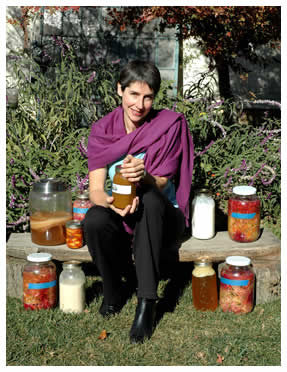 With that in mind, we are planning a “Kommunity Krauting” event when
the 2008 Spring shares arrive. Everyone can bring veggies to go into the kraut,
like we did in the workshop. We will all take turns cutting and pounding and
then go home with jars of Kommunity Kraut.
With that in mind, we are planning a “Kommunity Krauting” event when
the 2008 Spring shares arrive. Everyone can bring veggies to go into the kraut,
like we did in the workshop. We will all take turns cutting and pounding and
then go home with jars of Kommunity Kraut.
Here is a wonderful fermented vegetable recipe for beginners from “Nourishing
Traditions” (NT) called Ginger Carrots. This is a great one for introducing
kids, finicky adults, or even those “wascally wittle wabbits” to
the fermenting process! [Note: I’ve moved Stacy’s recipe to the recipe
section, below – Debbie]
Happy Fermenting,
Stacy Stafford Scott
<back to top>
Pictures around the farm
~~~~~~~~~~~~~~~~~~~~~~~~~~~~~~~~~~~~~~~~~~~~~~~~
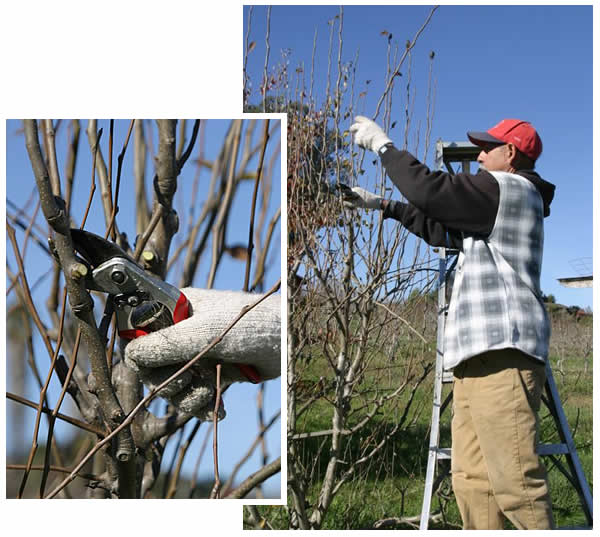
Here's Reynaldo pruning the pear trees...
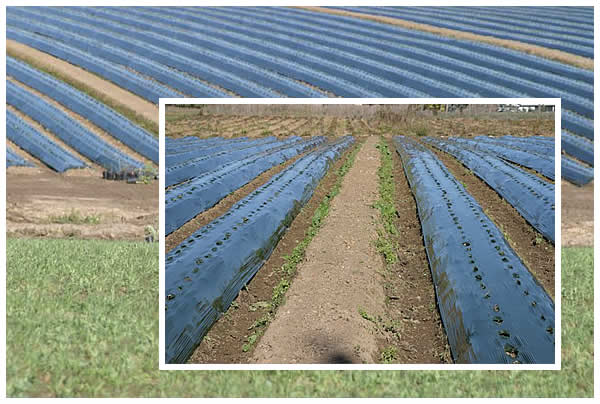
And our newly-mulched strawberry beds.
Below: the hedgerow planting adventure, with closeups of some of the natives
being planted.
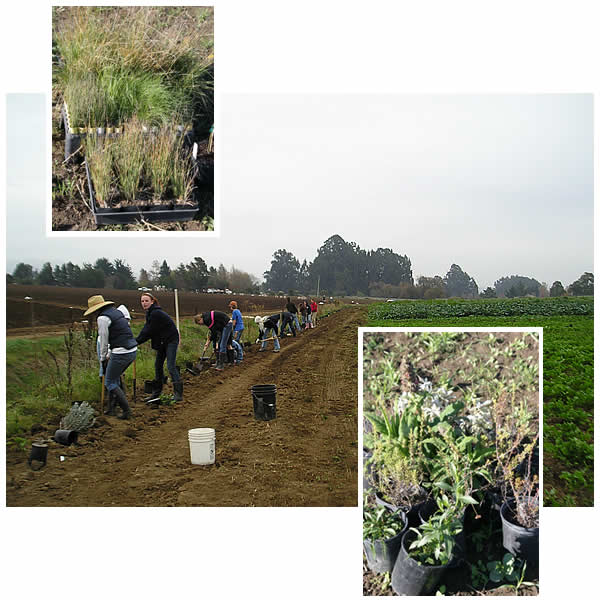
<back to top>
What's in the box this week
~~~~~~~~~~~~~~~~~~~~~~~~~~~~~~~~~~~~~~~~~~~~~~~~
Remember, sometimes unannounced substitutions will occur in your shares.
This list is as accurate as it can be... a day and a half before your
box is actually packed!
Apples
Brussels sprouts
Carrots
Cauliflower
Chard
Collard greens
Dinosaur (Lacinato) kale
Red Russian kale
Lettuce
Mustard greens
Radishes
Rosemary or cilantro
Winter squash
and bread (this week for the Santa Clara County pickup locations: Los Gatos,
Willow Glen, Santa Clara, Sunnyvale)
Note: cabbage heads are not quite mature, still a little loosely packed,
so we are going to leave them in the fields to 'dense up' - they should
be beautiful come first box in January!
<back to top>
Notes from Debbie's Kitchen
~~~~~~~~~~~~~~~~~~~~~~~~~~~~~~~~~~~~~~~~~~~~~~~~
Click
here to go to recipe database
Hard to believe that the end of the year is fast approaching!
Remember, the Winter CSA is taking a 3-week break; after your pickup this Wednesday
the 12th, the next delivery won’t be until January 9th. I hope that you
all have a wonderful, peaceful, joyful time with family and friends over the
holidays. Take care everyone, and I’ll talk to you in the new year! Okay,
on to the recipes. – Debbie
I am coming to the conclusion it’s an urban myth that people don’t
like Brussels sprouts. Honestly! I’ve been getting more recipes from people
on this one veggie – on how they cook them, and how popular their recipe
is with kids and friends – than any other.
Of course I have developed my own favorite recipe for cooking them, and even
modified it a bit based on Mark Steven’s recipe which he sent in last week.
I like to serve this for breakfast, but there’s no reason you couldn’t
eat it for lunch or dinner! To digress a bit more, I like working veggies into
my breakfast routine; for those of you who find it hard to use up your veggies
each week, start thinking about incorporating them into breakfast and lunch.
It’s easier than you think! ‘Course then you’ll end up like
me, where instead of having more veggies than I can use... I start to run short
before the week is out! Sometimes it’s hard to find a balance. Anyway,
here’s my recipe:
Brussels and eggs with feta
Brussels sprouts
eggs
butter
herbes de Provence
salt and pepper
feta cheese
Peel loose outer leaves and trim bottom of sprouts. Cut in half and steam about
4 to 5 minutes. Melt a generous amount of butter in a skillet over medium heat;
add steamed sprouts, cut side down (as much as possible) and cook a few minutes
while you whisk the eggs together with the herbs, salt and pepper. Pour egg mixture
over sprouts, turn heat to low and cover. Cook on low until eggs are just barely
set; crumble feta cheese liberally on top of eggs, cover, and turn off heat.
Let sit a minute or two, just enough for the feta to melt. You can either fold
it over at this point, or serve open-faced. It is delicious!
Here’s a Brussels recipe sent me by member Piper McNulty, who says (in
further support of my theory!), “This is so easy, and folks who hate Brussels
sprouts love them this way. This has become a regular request of my kids for
T-day and other special occasions.”
Kari’s Brussels Sprouts
brussels sprouts (a pound or so)
oil
brown sugar (1 tbsp. or so)
dry sherry (2 tbsp. or so)
1. Chop tough ends off sprouts, peel off any dirty/ bruised outer leaves, cut
in half lengthwise (and quarter any that are much larger than the rest).
2. Sauté w/ a little oil in a wok, med high heat, for a few minutes, until
lightly browned.
3. As needed, add a bit of water and cover to steam till just bright green and
just barely tender enough to eat (do not over cook!).
Toss in a small amount of of brown suger and a splash or two of sherry, mix to
heat, serve!
Dave Davis, another member, wrote me earlier saying, “I roasted the
Brussels sprouts after tossing them with olive oil, Celtic/sea salt, coarse ground
pepper - 450 for 25 minutes - for a wine /foodie group last night - the bowl
was half empty by the time it made it to the table! thanks for providing
such great veggies. I told everyone who asked the trick is to get fresh,
good produce.”
Okay, on to a different veggie! Here’s a great sounding chard recipe
sent to me by member Kim Couder. She says she got it out of the newspaper
years ago:
Italian Ruby Chard Custard
¼ C extra virgin olive oil
1 sweet red or yellow onion, peeled and chopped (I use regular yellow onions)
2 lbs. red chard (any kind would work fine), stems removed and discarded, leaves
cut into julienne
3/4 C milk
4 eggs
1 C grated Parmesan
1/8 tsp. freshly grated nutmeg
salt and pepper to taste
Preheat oven to 375. Lightly oil eight half-cup ramekins and place on baking
sheet. Sauté onions in olive oil over medium heat until softened but not
browned. Add chard and cook till tender.
Combine chard mixture with milk and puree till smooth in blender or food processor. Let
cool.
Beat eggs into chard mixture. Add cheese, nutmeg, salt and pepper. Pour
into ramekins and bake 30-35 min, or until a knife inserted in center comes out
clean.
And I love this one that Member Lisa Bautista sent me
awhile back; I've been saving it for when we got Lacinato/Dino (akaTuscan) kale
again. This is a very intriguing-sounding recipe she found in the New York Times
dining section. If you want to read the story behind the recipe (the story is
entitled, “If
It Sounds Bad, It’s
Got to Be Good”), here’s the link: http://www.nytimes.com/2007/10/24/dining/24appe.html?ref=dining
Raw Tuscan Kale Salad with Pecorino
1 bunch Tuscan kale (also known as black or lacinato kale)
1 thin slice country bread (part whole-wheat or rye is nice), or 1/4 cup homemade
bread crumbs (coarse)
1/2 garlic clove, finely chopped
1/4 cup finely grated pecorino cheese, more for garnish
3 tablespoons extra virgin olive oil, more for garnish
Freshly squeezed juice of 1 lemon
1/4 teaspoon kosher salt
1/8 teaspoon red pepper flakes
Freshly ground black pepper, to taste.
1. Trim bottom 2 inches off kale stems and discard. Slice kale, including ribs,
into 3/4-inch-wide ribbons. You should have 4 to 5 cups. Place kale in a large
bowl.
2. If using bread, toast it until golden on both sides. Tear it into small pieces
and grind in a food processor until mixture forms coarse crumbs.
3. Using a mortar and pestle, or with the back of a knife, pound garlic into
a paste. Transfer garlic to a small bowl. Add 1/4 cup cheese, 3 tablespoons oil,
lemon juice, salt, pepper flakes and black pepper, and whisk to combine. Pour
dressing over kale and toss very well to thoroughly combine (dressing will be
thick and need lots of tossing to coat leaves).
4. Let salad sit for 5 minutes, then serve topped with bread crumbs, additional
cheese and a drizzle of oil.
Yield: 2 to 4 servings.
[Fermented] Ginger Carrots
from “Nourishing Traditions” by
Sally Fallon, with added notes from personal experience by Stacy Scott - see
story above - [and a few by Debbie too]
Makes 1 quart
4 C grated carrots, tightly packed
1 tbsp. freshly grated ginger
2 tbsp. sea salt, approximately*
In a bowl, mix all ingredients and pound with a wooden pounder, French rolling
pin, or a meat hammer to release juices. [If you don’t happen to have any
of those tools, be creative; try an empty wine bottle, or make your own wood
pounder. Just be sure the wood is not chemically treated in any way. And if you
use a glass bottle, be smart and don't pound it in a glass bowl; let's not have
any breakage please!] Place pounded veggies and their juices in a quart-sized,
wide-mouth mason jar and press down firmly with pounder or meat hammer [or
your own clean fingers] until juices rise up to cover the carrots. The top of
the carrots should be at least 1 inch from the top of the jar [or if using an
open jar – see
my next inserted comment – you
might want to set the jar in a bowl or something; while it ferments, the contents
tends to expand and if your jar is filled close to the top, it can overflow a
little]. Stacy: The intent with fermenting veggies is to keep them from being
in contact with oxygen. Keeping them submerged just beneath the surface of the
liquid will suffice. If necessary, weigh them down with something like a smaller
jar filled with water, a cleaned river rock (NO LIMESTONE!!) or something made
of wood that would fit within the mouth of the jar. Sally Fallon says next to ‘cover
tightly’ [but
here I would add from my own experience, plus what I learned in the workshop,
that, like Stacy said, the key is really to keep the veggies under the liquid.
So if your weighting object doesn’t happen to fit nicely inside the bigger
vessel with its lid closed, leave the lid off and just drape a clean towel over
all to keep out errant flies or dust. The ferment will be perfectly fine]. Leave
at room temperature about 3 days before transferring to cold storage. Stacy: ‘cold
storage’ could
be any place that is cold and dark. You always want to keep your ferments out
of the sunlight.
Stacy: You can make smaller quantities if you just want to test the recipe, or
if we don’t have 4 cups of carrots in this weeks box. *The key with the
salt is to go by taste. Salt is a preservative. You could actually ferment the
veggies without salt; it just doesn’t taste as good. This receipt tastes
great either way. Fermentation is an art. Good flavor is in the “eye,” or
the taste buds, of the beholder. Have fun, experiment and let the kids get in
on the fun. You would be surprised how much they love having sauerkrauts with
their meals.
<back to top>
Contact Information
~~~~~~~~~~~~~~~~~~~~~~~~~~~
email Debbie at the farm (for any farm or CSA share-related business): farmers@cruzio.com
email Debbie at home (with newsletter input or recipes): deb@writerguy.com
farm phone: 831.763.2448
website: http://www.liveearthfarm.net
~~~~~~~~~~~~~~~~~~~~~~~~~~~